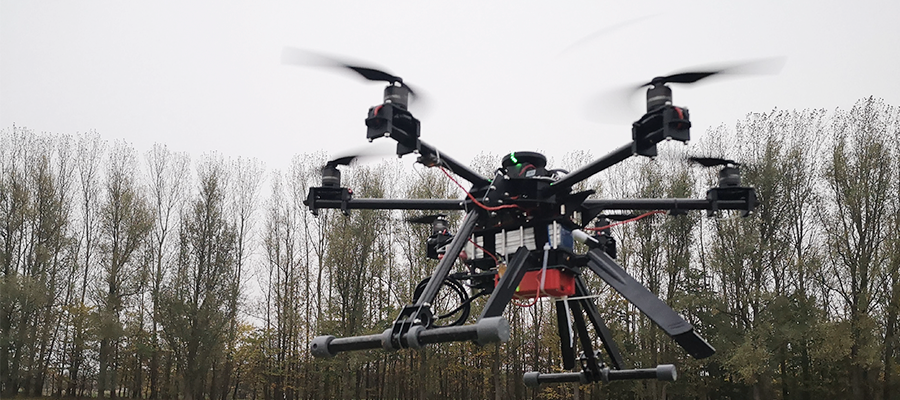A new era for drone technology: 5G brings new possibilities
Drones can be helpful for environmental monitoring, transport of medical equipment and various critical functions. And with the roll-out of the national 5G-network the risk of drones coming into conflict with existing air traffic can be eliminated. This has motivated a broad team of researchers and companies to launch an ambitious drone project with funding from Innovation Fund Denmark.

In recent years, drone technology has developed significantly in Denmark and abroad, and the development is likely to continue going forward.
“The opportunities of drone technology are vast, and we have only seen the tip of the iceberg. With the 5G-network, we are on the brink of a new era with completely new applications that not only benefit the drone industry, but also the green transition”, says Professor in Aerial Robotics Ulrik Pagh Schultz from the University of Southern Denmark, who is leading the Grand Solutions project GENIUS. The project has a total budget of DKK 3.2 million EUR, of which 1.9 million EUR comes from Innovation Fund Denmark.
The partners in the project include Naviair, who manages traffic in Danish airspace, network companies TDC NET and Ericsson, Lorenz Technology, that develops intelligent drone solutions, and the Danish universities DTU and SDU. The project aims to develop a 5G network for the low airspace.
The roll-out of 5G has made it possible to establish a so-called U-Space, where drones can fly safely next to the traditional manned air traffic, also beyond the drone pilots’ line of sight. “Ultimately the ambition is to enable the drone to operate autonomously, while being monitored by the automatic traffic control system that is being developed by Naviair as part of the project”, says Ulrik Pagh Schultz.
Network at a height of 100 meters
The automatic traffic control system relies on a network with high reliability and low response time, which is exactly what 5G delivers.
The national 5G-network was established by TDC NET with support from Ericsson by the end of 2020, focusing of course mainly on 5G coverage at ground level. But if the drones are to use 5G, the coverage should be expanded into the lower airspace. TDC NET and Ericsson’s joint 5G Innovation Hub will establish this as part of the GENIUS project.
“Already today, large amounts of data can be sent and received in close to real time via the national 5G-network, TDC NET rolled out in 2020. As 5G coverage is expanded also to the lower airspace, drones will be able to solve far more advanced tasks for the benefit of companies and society at large. We look forward to realizing that potential,” says Michael Fränkle, Executive Vice President of TDC NET.
U-space
Naviair, who is responsible for traffic management of aviation in Danish airspace, will handle the connection between 5G and the automatic traffic management system, which is a prerequisite for the establishment of U-space – the so-called UAS Traffic Management (UTM) platform.
U-space will ensure that unmanned drones in the future can fly in the same airspace as manned air traffic without posing a danger when, for example, they monitor birds in the Wadden Sea, fly critical medical equipment between hospitals, or inspect port areas.
“Naviair is focusing on building a complete infrastructure for drones in Danish airspace, where drones can operate outside the drone operator’s field of vision (BVLOS), which will scale up the application possibilities for drones. 5G is a central technology in several areas, where we, among other things, expect to be able to create a live image of the traffic situation in the air at any time, ”says Christian Clemmensen Møller, UTM Business Developer at Naviair.
Possible commercial adventure in sight
One of the companies that can benefit from the technological advances in the drone field is Lorenz Technology. The company specializes in developing intelligent, versatile, and user-friendly drone solutions, which for example are used for inspection of ports.
“The project helps to maintain and expand Denmark’s role as one of the leading nations in the explosively growing drone market. It can enable us to use drones for completely new tasks, e.g., inspection of infrastructures in urban environments, where today it is not legal to fly drones out of sight of the drone pilot, ” says Anders Olsen from Lorenz Technology.
According to Drone Industry Insights, revenue in drone transport will grow from $14 billion in 2018 to $43 billion in 2024. The attractiveness of the market is further emphasized by the predictions of the European Commission that the European drone sector in 2035 will employ more than 100,000 people directly and have an economic effect of over 10 billion euros per year.
Can lift the green transition to new heights
The GENIUS project can also become an important player in the green transition. GENIUS will, in collaboration with the Danish Environmental Protection Agency, investigate how drones can help preserve our nature. The idea is that significant parts of the National Monitoring Program for the Aquatic Environment and Nature (NOVANA) will be able to be carried out by fully automated drones, which autonomously collect data from the nature areas that are being monitored. Unmanned drones can thus play an important role in monitoring, for example, eelgrass by the Wadden Sea or in connection with the counting of birds and rare animal species.
Contact
Ulrik Pagh Schultz, GENIUS project manager, Professor, SDU UAS Center, ups@mmmi.sdu.dk, +4565503570
